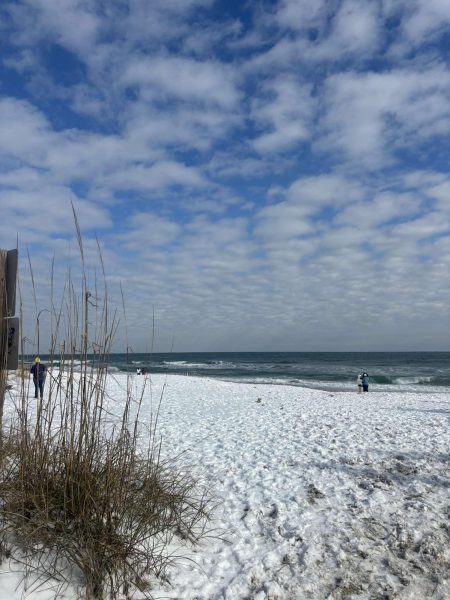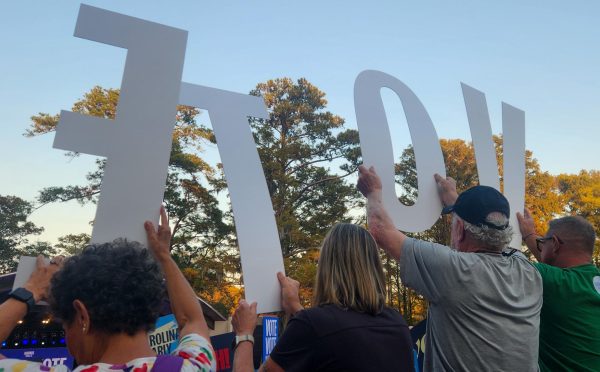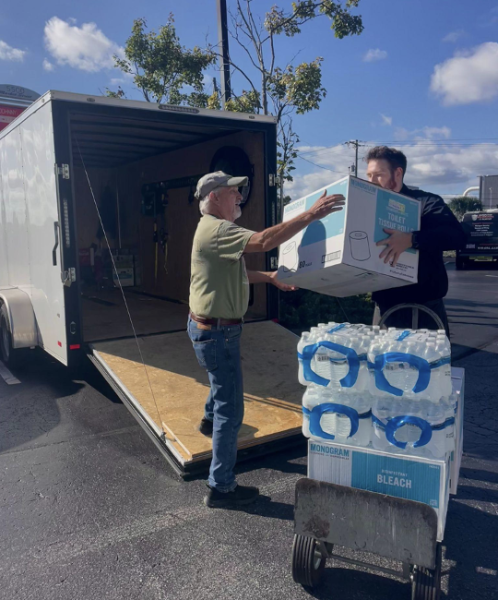Wilmington’s role as one of the worst cities for heroin and opioid abuse
Editor’s note: This article serves as an elaboration on a shorter article published by The Seahawk in August on the same topic.
JACKSONVILLE—The desolate podium with the presidential seal stands alone. Two iconic pieces of fabric—the American flag and the flag of the President of the United States—flank the platform in front of the velvet blue curtain. Silhouetted journalists stand in silence—and in walks Nixon.
It’s June 17, 1971.
Veterans are protesting the war, the trade embargo between the U.S. and China has ended, and just four days before President Richard M. Nixon would walk out before this room of scribes, The New York Timeswould begin to publish the classified Pentagon Papers, exposing systematic lies from the White House about the war in Vietnam to Congress and the American citizenry.
But on this day, war will be declared on a different enemy.
“America’s public enemy number one in the United States is drug abuse. In order to fight and defeat this enemy, it’s necessary to wage a new, all-out offensive,” Nixon said.
That was 45-years-ago.
Today, we’re still at war and the “enemy” shows no signs of defeat, especially in Wilmington—the number one city in America for heroin and opioid abuse, according to Castlight Health, a health care information company.
How did we get here? The question is simple; the answer is not.
A NATIONAL PROBLEM
Wilmington is a microcosm of the larger issue that has metastasized throughout the country.
The issue has become so prevalent that President Barack Obama this past July signed the Comprehensive Addictions and Recovery Act, which seeks to provide new policies for medical care professionals prescribing prescription opioids such as Vicodin and Oxycontin. The law seeks to scale back needless opioid prescriptions to addiction-prone patients.
The new provisions come just seven months after newly released statistics from the Centers for Disease Control and Prevention show a spike of heroin and prescription painkiller overdoses in 2014. The record breaking year shows that 47,000 people died.
However, despite attempts to quell the death toll through legislation first introduced by Sen. Sheldon Whitehouse (D-R.I.) critics assert that tighter prescription regulations are contributing to the growth in heroin use across the country.
“What’s happened is that some of the pills, like Oxycontin and Vicodin have gotten such a reputation that they have become more restrictive, so it’s more difficult to get that medication for people who are addicted to it,” said Jacksonville Police Chief Michael Yaniero in an interview with The Seahawk. “Heroin being a cheap [alternative] has replaced these prescription drugs.”
Yet, a study published in the New England Journal of Medicine by the National Institute on Drug Abuse contend that the current heroin and opioid epidemics are not consistent with increased controls on opioid-laced prescription drugs, as the rate of emergency room visits and hospitalization from heroin-related issues were surging years before the 2009-2011 time frame of tighter prescription controls, according to The Washington Post.
Additionally, the study noted that fatal heroin overdoses began rising in 2007, a full two years before the first policy provisions would be introduced.
The Drug Abuse Institute points to the new heroin markets that provide greater access to opioids as the catalyst for the national rise in heroin and opioid related deaths—not tighter regulations on prescription drugs containing opioids.
“Heroin is cheap and easy to get [in Wilmington],” Lt. Jerry Brewer of the New Hanover County Sheriff’s Office told this reporter in 2015, who then published it in a documentary for WingSpan.
“It’s been in good supply from all over the world, so when you have a high supply and a high demand that can cause you many problems.”
Yaniero says that the drug trade in Wilmington has extended to Jacksonville.
“With heroin, you also get the violence that comes with it. I hate to say it, but the drug traffickers are coming to Jacksonville because there is unfortunately a market for it here, in Wilmington and across North Carolina,” said Chief Michael Yaniero.
UNC Wilmington Police Chief Maj. Chris Bertram told WingSpan earlier this year that, “What we have here on campus is recreational drug use. In 2015, every drug violation that we became aware of involved marijuana, except for one and that one case was meth. We believe that there is probably heroin use on campus, but we have not found any.”
A REQUEST FOR HELP IN GANGLAND
It was August 2014 when the city of Wilmington knew it needed help.
The Criminal Conspiracy Unit, a joint task force between the Wilmington Police Department and New Hanover County Sheriff’s Office, had already identified 400 gang members operating within the area back in 2010, according to WECT6, an NBC News affiliate.
The United Blood Nation Gang and its associate organizations; the “1090s” or “Double I’s;” MS 13, a mostly Salvadorian gang originating out of Los Angeles; The Bloods’ longstanding revival, the Crips; the outlaw motorcycle club, the Hells Angels; and the Mexican cartel, La Familia Michoacana are all operating in and around the Wilmington area.
Today, there are between 21 and 40 different gangs in New Hanover County, according to a 2015 report from the N.C. Highway Patrol.
Data shows that 73 percent of validated gang members are between the ages of 18 and 25-years-old, which represents a 7 percent increase from 2014.
26 to 35-year-old age group has plummeted from 52 percent in 2014 to 17 percent in 2015. 625 gang members are 17-years-old and younger.
Moreover, the data speculates that socioeconomic variables within different North Carolina communities is the main factor behind black and Hispanic representation in North Carolina gangs, which stand in disproportion to other race and ethnicity groups in the region.
The gangs’ product of choice—Heroin.
In 2014, the Mayor’s Office took the administrative steps to request assistance from the federal government’s Office of National Drug Control Policy or ONDCP, according to public documents obtained by The Seahawk.
The D.C. office has the sole mandate in establishing policy and national objectives aimed at reducing the manufacturing, distributing and illicit use of narcotics. Wilmington requested ONDCP to designate their county a High Intensity Drug Trafficking Area or HIDTA, due to the increasing heroin problem from narco-traffickers.
For Wilmington to be granted federal assistance, officials have to show that the area is a significant center for illegal drug manufacturing and distributing to include an aggressive posture from the local police department to stem the tide of drug trafficking within the area.
According to the National Drug Reauthorization Act of 2006, officials also have to demonstrate that the flow of drugs is having “a significant harmful impact in the area and other areas and that an allocation of federal resources is necessary to respond adequately to drug related activities,” according to language within the act.
A 2015 HIDTA map from the White House shows 15 districts have already received high-intensity designation in North Carolina. However, ONDCP has no record of designating Wilmington or New Hanover County as a HIDTA, according to the National Archives and Records Administration
A request for comment was sent to ONDCP, but was not immediately returned.
This past July, a task force was formed between the FBI’s Charlotte Division, the Brunswick and New Hanover County sheriffs’ offices, the N.C. State Bureau of Investigation and the FBI’s Coastal Carolina Criminal Enterprise Task Force, according to the Star News.
The task force is aimed at stemming the transportation and flow of illicit narcotics throughout North Carolina by numerous gangs, as it continues to be problematic from the eastern part of the U.S. down to Mexico, according to a report from the Office of National Drug Control Policy.
New Hanover County District Attorney Ben David told the Star News that “We know the community has been affected by this, [but] I think you are going to start seeing real results from this task force.”
DRUG HIGHWAY AND INTERNATIONAL HEROIN
Back in August 2014, five members of the United Blood Nation Gang, the East Coast version of The Bloods from Los Angeles, Calif., pleaded guilty for trafficking heroin in New Hanover County when deputies found 2,718 glassine bags of heroin upon issuing a search warrant.
Investigators determined that the five members were connected to the Bloods in New Jersey, according to Star News.
Wilmington’s I-40 corridor, which connects to I-95, is a key transit hub for narcotics traffickers.
Special Agent Timothy McMahon from the New Jersey Drug Enforcement Agency spoke to this reporter on how the narcotics are transported down to Wilmington; The interview was originally published in a documentary for WingSpan earlier this year.
“There are several different routes that are being used. Obviously some of it is coming over the southwest boarder and then from there via tractor-trailer. Smaller packages are hidden in cars and driven to different locations throughout the country,” McMahon said.
Four days before the city of Wilmington requested government assistance to stem the flow of heroin into the Port City, the Special Inspector General for Afghanistan Reconstruction, or “SIGAR,” released a report showing that poppy cultivation was at an all-time high despite $7.8 billion dollars being spent on counter narcotic operations in America’s longest war zone.
Special Inspector General John F. Sopko underlined several trends that are occurring within the Afghan fields and calls into question the effectiveness of the U.S. strategy to eradicate the narcotics trade in Afghanistan.
“Despite spending over $7 billion to combat opium poppy cultivation and to develop the Afghan Government’s counter narcotics capacity, opium poppy cultivation levels in Afghanistan hit an all-time high in 2013,” according to the memorandum obtained by The Seahawk.
According to the United Nations Office on Drugs and Crime, Afghan farmers grew an unprecedented 209,000 hectares of opium poppy in 2013, surpassing the previous record of 193,000 hectares in 2007.
“With deteriorating security in many parts of rural Afghanistan and low levels of eradication of poppy fields, further increases in cultivation are likely in 2014 and 2015,” Spoko said.
Alex Bronstein-Moffly, the former Public Affairs Director for SIGAR, confirmed to The Seahawk that in a sworn testimony to Congress back in January 2014, Afghanistan currently produces 80 percent of the world’s opium and that four percent of that can be found in the United States, according to reports given to SIGAR from the U.S. Drug Enforcement Agency.
Veryan Khan, who is the Editorial Director for the Terrorism Research & Analysis Consortium, told The Seahawk that the 4 percent of Afghan heroin entering the U.S. is likely being funneled through the Sahel in Africa, which than gets brokered out to different countries.
The Seahawk has not been able to determine what percentage of heroin in Wilmington originated in Afghanistan; However, New Hanover Sheriff’s office, New Hanover D.A. Ben David and the Jacksonville Police Department have all either confirmed or suggested that some of the heroin in Wilmington is from Afghanistan—opium tied to the Taliban, a terrorist organization in that region.
“I think the more people understand the ripple effect of crime, the more they won’t fund it,” David told WingSpan earlier this year.
“We think of terror as far off and overseas, but where does heroin come from? It’s the poppy fields of Afghanistan. Where are the murders occurring? On the border with Mexico, where you have Central America desperate to get here with these drugs to sell them to the people,” David said.
“What we frequently don’t understand,” he said, “is that the terror happening in our backyard, the shootings in open daylight, the home invasions, that’s all related to drug activity […] if you think that children killing children is unacceptable, stop using heroin.”
James LaPorta can be found on Twitter @JimLaPorta











